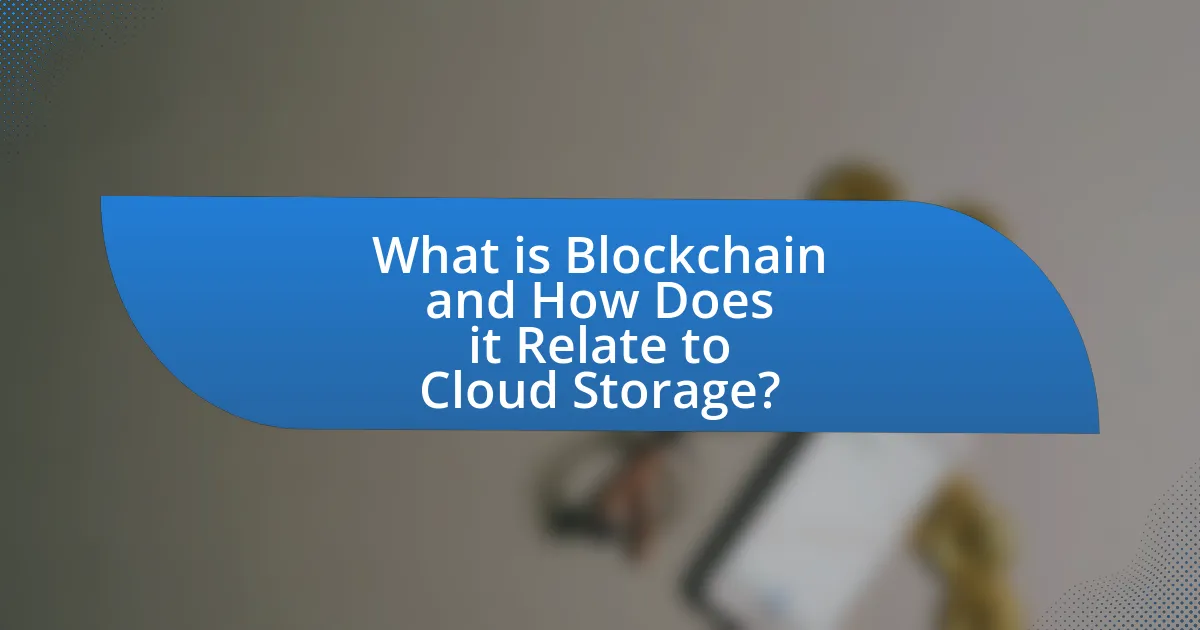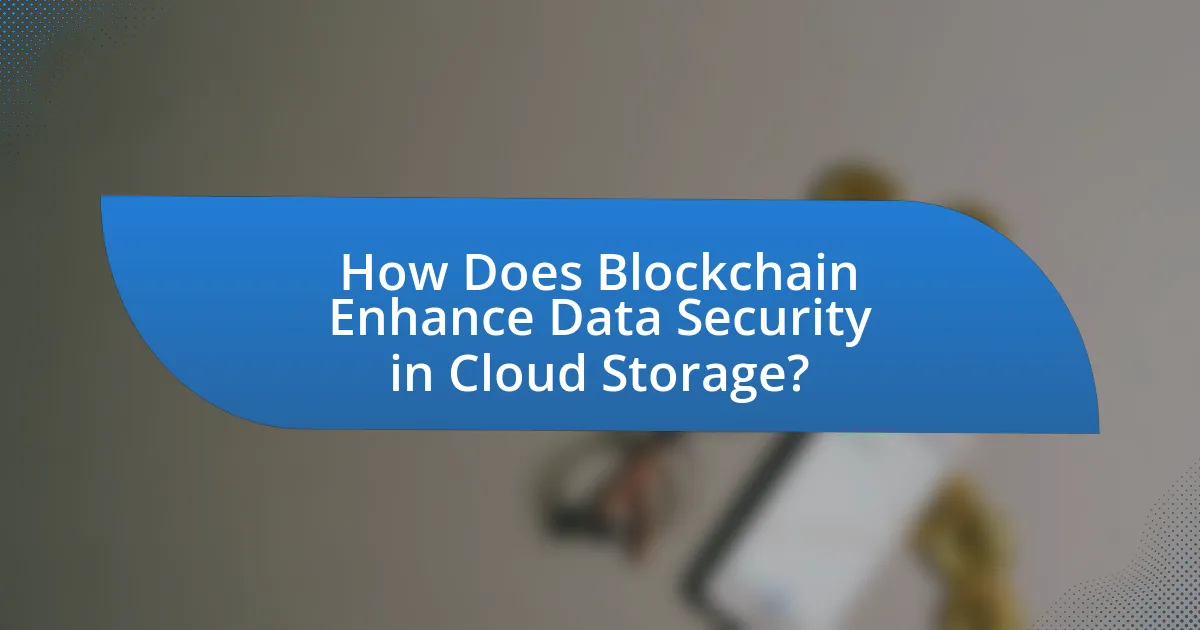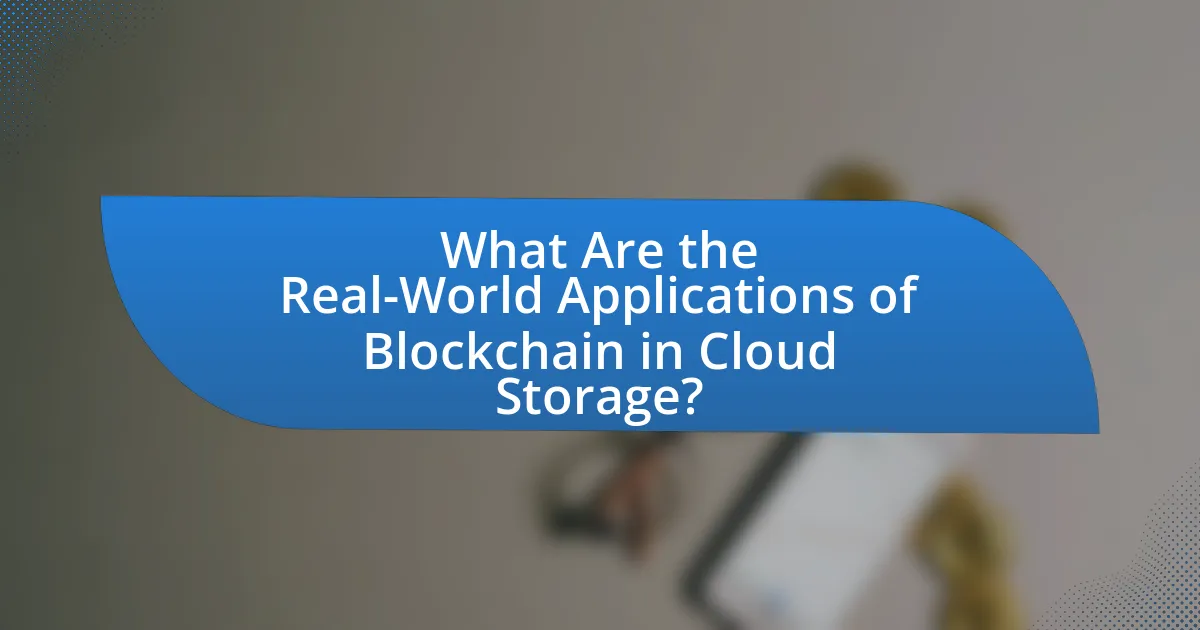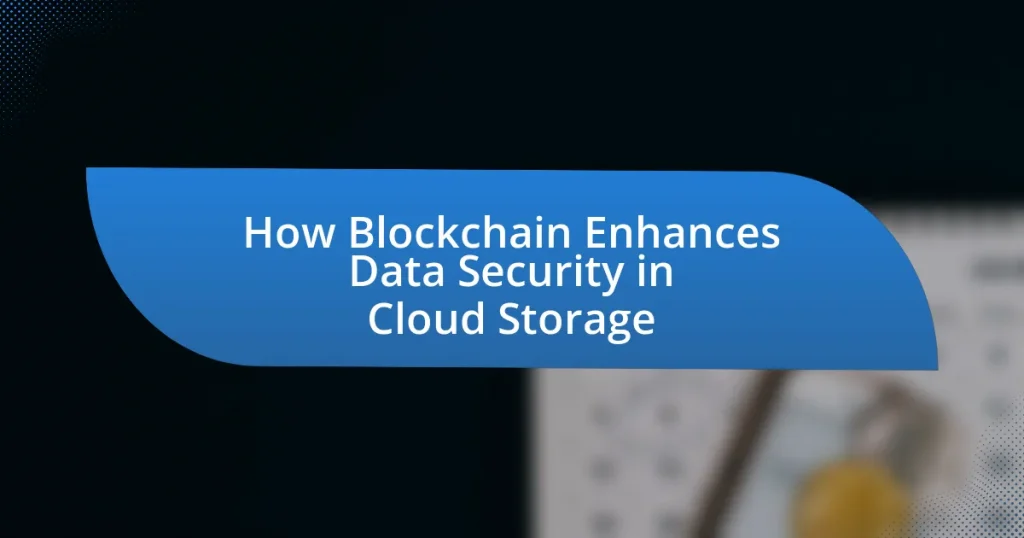Blockchain is a decentralized digital ledger technology that enhances data security in cloud storage by providing a transparent and tamper-proof method for storing and sharing data. This article explores how blockchain functions, its key components, and the mechanisms it employs to secure data, such as cryptographic hashing and consensus algorithms. It also addresses the primary challenges of data security in traditional cloud storage systems, the implications of immutability for data integrity, and the real-world applications of blockchain across various industries, including finance and healthcare. Additionally, the article discusses the potential drawbacks of blockchain integration, best practices for implementation, and the steps organizations should take to ensure successful adoption.

What is Blockchain and How Does it Relate to Cloud Storage?
Blockchain is a decentralized digital ledger technology that securely records transactions across multiple computers, ensuring that the recorded data cannot be altered retroactively. In relation to cloud storage, blockchain enhances data security by providing a transparent and tamper-proof method for storing and sharing data. This is achieved through cryptographic hashing and consensus mechanisms, which verify and validate transactions before they are added to the blockchain. For instance, a study by IBM highlights that integrating blockchain with cloud storage can significantly reduce the risk of data breaches and unauthorized access, as each transaction is securely logged and can be audited without compromising the integrity of the data.
How does blockchain technology function?
Blockchain technology functions as a decentralized and distributed ledger that records transactions across multiple computers in a way that ensures the security, transparency, and immutability of the data. Each transaction is grouped into a block, which is then linked to the previous block, forming a chain. This structure prevents unauthorized alterations, as changing any information in a block would require altering all subsequent blocks, which is computationally impractical due to the consensus mechanisms employed, such as Proof of Work or Proof of Stake. The decentralized nature of blockchain means that no single entity has control over the entire chain, enhancing security against data breaches and fraud.
What are the key components of blockchain technology?
The key components of blockchain technology are decentralization, immutability, transparency, and consensus mechanisms. Decentralization ensures that no single entity controls the entire network, which enhances security and reduces the risk of data tampering. Immutability refers to the inability to alter recorded data without consensus from the network, making it reliable for storing sensitive information. Transparency allows all participants to view the transaction history, fostering trust among users. Consensus mechanisms, such as Proof of Work or Proof of Stake, validate transactions and maintain the integrity of the blockchain. These components collectively contribute to the robustness and security of blockchain systems, particularly in applications like cloud storage.
How does decentralization enhance security in blockchain?
Decentralization enhances security in blockchain by distributing data across a network of nodes, making it difficult for any single entity to manipulate or compromise the system. This distribution means that even if one node is attacked or fails, the integrity of the entire network remains intact, as the data is replicated across multiple locations. Furthermore, the consensus mechanisms employed in decentralized networks, such as proof of work or proof of stake, require agreement from a majority of nodes to validate transactions, thereby preventing unauthorized changes. This structure significantly reduces the risk of data breaches and fraud, as altering the blockchain would necessitate overwhelming control over the majority of nodes, which is highly impractical in a well-distributed network.
What are the primary challenges of data security in cloud storage?
The primary challenges of data security in cloud storage include data breaches, loss of control over data, and compliance with regulations. Data breaches occur when unauthorized individuals gain access to sensitive information, which has been a significant concern, with reports indicating that 60% of companies experienced a data breach in the past year. Loss of control arises because data is stored off-site, making it difficult for organizations to manage and protect their information effectively. Additionally, compliance with regulations such as GDPR and HIPAA poses challenges, as organizations must ensure that their cloud storage solutions meet stringent legal requirements, which can vary by region and industry.
What vulnerabilities exist in traditional cloud storage systems?
Traditional cloud storage systems are vulnerable to data breaches, unauthorized access, and data loss. These vulnerabilities arise from centralized data management, which creates a single point of failure that can be exploited by cybercriminals. For instance, a 2020 report by the Identity Theft Resource Center indicated that data breaches in cloud services increased by 33% compared to the previous year, highlighting the growing risk associated with traditional cloud storage. Additionally, inadequate encryption practices can expose sensitive data during transmission and storage, making it accessible to malicious actors. Furthermore, reliance on third-party providers can lead to compliance issues and potential data mishandling, as evidenced by the 2019 Capital One breach, where a misconfigured firewall allowed unauthorized access to over 100 million customer accounts.
How do data breaches impact organizations using cloud storage?
Data breaches significantly impact organizations using cloud storage by compromising sensitive information, leading to financial losses, reputational damage, and legal repercussions. For instance, a 2020 report by IBM found that the average cost of a data breach was $3.86 million, highlighting the financial burden organizations face. Additionally, breaches can erode customer trust; according to a survey by PwC, 87% of consumers will take their business elsewhere if they feel their data is not secure. Legal consequences also arise, as organizations may face lawsuits and regulatory fines, particularly under laws like GDPR, which imposes strict penalties for data protection violations. Thus, the ramifications of data breaches extend beyond immediate financial costs, affecting long-term organizational viability and stakeholder relationships.

How Does Blockchain Enhance Data Security in Cloud Storage?
Blockchain enhances data security in cloud storage by providing a decentralized and immutable ledger for data transactions. This technology ensures that once data is recorded on the blockchain, it cannot be altered or deleted, which significantly reduces the risk of data tampering and unauthorized access. Additionally, blockchain employs cryptographic techniques to secure data, making it accessible only to authorized users. For instance, a study by IBM highlights that blockchain can reduce data breaches by up to 80% due to its inherent security features. This combination of decentralization, immutability, and cryptography makes blockchain a robust solution for enhancing data security in cloud storage environments.
What mechanisms does blockchain use to secure data?
Blockchain secures data through mechanisms such as cryptographic hashing, consensus algorithms, and decentralized storage. Cryptographic hashing ensures that data is transformed into a fixed-size string of characters, making it nearly impossible to alter without detection. Consensus algorithms, like Proof of Work or Proof of Stake, validate transactions across the network, ensuring that only legitimate data is added to the blockchain. Decentralized storage distributes data across multiple nodes, reducing the risk of a single point of failure and enhancing data integrity. These mechanisms collectively create a robust framework for securing data in cloud storage environments.
How does encryption work within blockchain technology?
Encryption within blockchain technology secures data by converting it into a format that is unreadable without a decryption key. This process involves cryptographic algorithms, such as SHA-256, which generate a unique hash for each block of data, ensuring that any alteration in the data results in a completely different hash. This characteristic provides integrity and authenticity, as any tampering can be easily detected. Additionally, public-key cryptography is utilized, where each user has a pair of keys: a public key for encryption and a private key for decryption. This method ensures that only the intended recipient can access the data, enhancing security. The decentralized nature of blockchain further protects encrypted data, as it is distributed across multiple nodes, making unauthorized access or data breaches significantly more difficult.
What role do smart contracts play in data security?
Smart contracts play a crucial role in data security by automating and enforcing agreements without the need for intermediaries. They ensure that data transactions are executed only when predefined conditions are met, reducing the risk of unauthorized access or manipulation. For instance, smart contracts can automatically trigger data encryption or access permissions based on specific criteria, thereby enhancing the integrity and confidentiality of stored data. This automation minimizes human error and potential vulnerabilities associated with manual processes, as evidenced by the use of smart contracts in decentralized finance (DeFi) applications, which have demonstrated a significant reduction in fraud and data breaches.
Why is immutability important for data security?
Immutability is crucial for data security because it ensures that once data is recorded, it cannot be altered or deleted, thereby preventing unauthorized modifications. This characteristic is fundamental in blockchain technology, where each transaction is cryptographically linked to the previous one, creating a secure and tamper-proof ledger. For instance, in a study by Nakamoto in 2008, the introduction of blockchain demonstrated that immutability could significantly reduce fraud and data breaches, as any attempt to change a record would require altering all subsequent blocks, which is computationally infeasible. Thus, immutability enhances trust and integrity in data management, particularly in cloud storage environments.
How does immutability prevent unauthorized data alterations?
Immutability prevents unauthorized data alterations by ensuring that once data is recorded on a blockchain, it cannot be changed or deleted. This characteristic is achieved through cryptographic hashing and consensus mechanisms, which create a secure and verifiable record of transactions. Each block in the blockchain contains a unique hash of the previous block, forming a chain that is tamper-evident; any attempt to alter a block would change its hash and break the chain, alerting the network to the unauthorized change. Additionally, the decentralized nature of blockchain means that no single entity has control over the entire database, further protecting against unauthorized modifications.
What are the implications of immutability for data integrity?
Immutability significantly enhances data integrity by ensuring that once data is recorded, it cannot be altered or deleted. This characteristic prevents unauthorized modifications and maintains a reliable audit trail, which is crucial for verifying the authenticity of data. For instance, in blockchain technology, each block of data is cryptographically linked to the previous one, making it nearly impossible to change any information without altering all subsequent blocks. This structure not only protects against tampering but also fosters trust among users, as they can be confident that the data remains unchanged over time.

What Are the Real-World Applications of Blockchain in Cloud Storage?
Blockchain technology is applied in cloud storage to enhance data security through decentralized data management, ensuring data integrity, and enabling secure access control. Real-world applications include decentralized file storage systems like Filecoin and Storj, which utilize blockchain to distribute data across multiple nodes, reducing the risk of data breaches. Additionally, blockchain enables immutable audit trails for data access and modifications, as seen in platforms like VeChain, which helps organizations maintain compliance and transparency. Furthermore, smart contracts on blockchain facilitate automated and secure data sharing agreements, exemplified by projects such as Sia, which streamline transactions and enhance user trust. These applications demonstrate how blockchain effectively addresses security challenges in cloud storage environments.
Which industries are adopting blockchain for cloud storage security?
The finance, healthcare, supply chain, and government sectors are adopting blockchain for cloud storage security. In the finance industry, blockchain enhances transaction security and transparency, reducing fraud risks. Healthcare organizations utilize blockchain to secure patient data and ensure compliance with regulations like HIPAA. The supply chain sector benefits from blockchain by improving traceability and reducing data tampering, which is crucial for maintaining product integrity. Government agencies are exploring blockchain for secure record-keeping and identity verification, enhancing public trust and data protection. These industries leverage blockchain’s decentralized nature to bolster security and integrity in cloud storage solutions.
How is blockchain being used in healthcare data management?
Blockchain is being used in healthcare data management to enhance data security, interoperability, and patient privacy. By creating a decentralized and immutable ledger, blockchain allows for secure sharing of patient records among authorized parties while maintaining data integrity. For instance, a study published in the Journal of Medical Internet Research highlights that blockchain can reduce data breaches by ensuring that only authorized users can access sensitive information, thus protecting patient privacy. Additionally, blockchain facilitates interoperability between different healthcare systems, enabling seamless data exchange and improving care coordination.
What benefits does blockchain provide for financial services in cloud storage?
Blockchain enhances financial services in cloud storage by providing increased security, transparency, and efficiency. The decentralized nature of blockchain technology ensures that data is stored across multiple nodes, making it resistant to tampering and unauthorized access. This is particularly crucial for financial services, where data integrity and confidentiality are paramount. Additionally, blockchain’s immutable ledger allows for real-time tracking of transactions, reducing the risk of fraud and errors. According to a report by Deloitte, implementing blockchain in financial services can lead to a 30% reduction in operational costs due to improved efficiency and reduced reconciliation times.
What are the potential drawbacks of using blockchain in cloud storage?
The potential drawbacks of using blockchain in cloud storage include scalability issues, high energy consumption, and complexity in integration. Scalability is a significant concern as blockchain networks can become congested, leading to slower transaction times and increased costs. For instance, Bitcoin’s network has faced delays and high fees during peak usage periods. High energy consumption is another drawback, as the proof-of-work consensus mechanism used by many blockchains requires substantial computational power, raising environmental concerns. Additionally, the complexity of integrating blockchain technology with existing cloud infrastructure can pose challenges for organizations, requiring specialized knowledge and resources to implement effectively.
How does scalability affect blockchain implementation in cloud storage?
Scalability significantly impacts blockchain implementation in cloud storage by determining the system’s ability to handle increasing amounts of data and transactions efficiently. As cloud storage demands grow, a scalable blockchain solution ensures that performance remains optimal without compromising speed or security. For instance, traditional blockchains like Bitcoin face limitations in transaction throughput, processing only about seven transactions per second, which can lead to delays and increased costs in a cloud storage context. In contrast, scalable solutions such as sharding or layer-2 protocols can enhance transaction speeds and reduce costs, making blockchain more viable for extensive cloud storage applications. This scalability is crucial for maintaining data integrity and security while accommodating the dynamic needs of cloud environments.
What are the costs associated with integrating blockchain technology?
The costs associated with integrating blockchain technology include initial setup expenses, ongoing maintenance fees, and transaction costs. Initial setup expenses can range from thousands to millions of dollars, depending on the complexity of the blockchain solution and the infrastructure required. Ongoing maintenance fees typically involve costs for software updates, security measures, and system monitoring, which can also accumulate significantly over time. Additionally, transaction costs, which are fees paid for processing transactions on the blockchain, can vary based on network congestion and the specific blockchain used, impacting overall operational costs. For instance, Ethereum’s transaction fees have fluctuated widely, sometimes exceeding $50 per transaction during peak periods, illustrating the potential financial burden of blockchain integration.
What best practices should organizations follow when implementing blockchain for data security?
Organizations should follow several best practices when implementing blockchain for data security, including ensuring robust encryption, establishing clear governance policies, and conducting regular audits. Robust encryption protects data integrity and confidentiality, as blockchain technology inherently uses cryptographic techniques to secure transactions. Clear governance policies define roles and responsibilities, ensuring compliance with regulations and standards, which is crucial for maintaining data security. Regular audits help identify vulnerabilities and ensure that the blockchain implementation adheres to security protocols, thereby enhancing overall data protection. These practices collectively contribute to a secure and efficient blockchain environment for data security in cloud storage.
How can organizations assess their readiness for blockchain adoption?
Organizations can assess their readiness for blockchain adoption by evaluating their current technological infrastructure, understanding the specific use cases for blockchain within their operations, and analyzing their workforce’s skill set. A comprehensive readiness assessment involves conducting a gap analysis to identify existing capabilities versus what is required for successful blockchain implementation. For instance, a report by Deloitte highlights that 39% of organizations have already begun exploring blockchain solutions, indicating a growing trend towards adoption. Additionally, organizations should consider regulatory compliance and data security implications, as blockchain can enhance data security in cloud storage by providing immutable records and decentralized control.
What steps should be taken to ensure a successful blockchain integration?
To ensure a successful blockchain integration, organizations should follow a structured approach that includes defining clear objectives, selecting the appropriate blockchain platform, and ensuring stakeholder engagement. Clear objectives help in aligning the integration with business goals, while choosing the right platform—such as Ethereum or Hyperledger—ensures compatibility with existing systems. Engaging stakeholders, including IT teams and end-users, fosters collaboration and addresses concerns early in the process. Additionally, conducting thorough testing and validation of the blockchain solution is crucial to identify potential issues before full deployment. These steps are supported by industry practices that emphasize the importance of planning and stakeholder involvement in technology integrations, as seen in successful case studies across various sectors.


